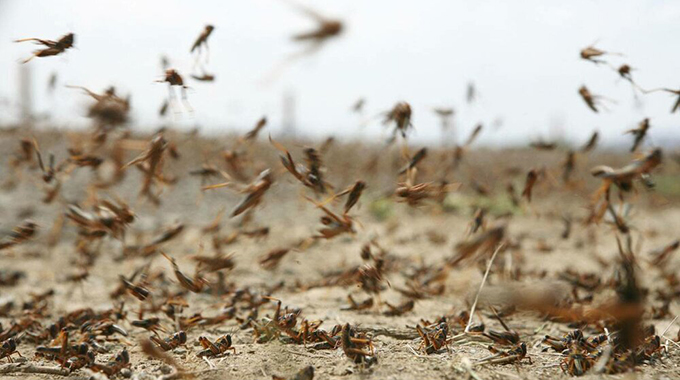Locust control operations stepped up

Sifelani Tsiko Agric & Environment Editor
Locust control and prevention management campaigns have been stepped up in Masvingo Province where locust outbreaks were reported in June.
Mr Shingirai Nyamutukwa, head of the Plant Quarantine and Plant Protection Research Services Institute, said recently that the training of agricultural extension workers and farmers was underway in affected districts of Masvingo, which has some of the country’s major sugarcane, maize, wheat and traditional grain production.
“Ever since there was an outbreak of the African migratory locusts in June this year, we have been working on the ground with agricultural extension workers and farmers to better prepare the affected communities,” he said.
“Historically sugarcane estates and conservation areas are known to be the breeding sites of the African migratory locusts, as such in years of outbreaks locust swarms feed on sugarcane and migrate into other provinces destroying other crops such as maize and millet as well as pastures.
“Locust cause damage and causelosses that negatively impact on human livelihoods. Currently the locusts are still a threat to districts in Masvingo since adult populations seen in mid-July to early August are now expected to have laid eggs.”
The Plant Protection Research Institute in partnership with the Enhancing Community Resilience and Sustainability (ECRAS) under the Zimbabwe Resilience Building Fund was holding training programmes in the affected districts of Chiredzi and Mwenezi in Masvingo province.
The training was targeting all wards in the two districts focusing on training on the locust life-cycle, identification and management.
“All wards were trained in Mwenezi and Chiredzi districts including those that do not fall under ECRAS,” Mr Nyamutukwa said.
“A total of 163 extension workers were trained from August 31 to September 10, 2020 in Chiredzi and Mwenezi covering a total of 61 wards. The training helped participants in preparing their disaster risk reduction work plans,” he said.
In these work plans, he said, each agriculture extension worker was expected to train more 200 farmers on surveillance, monitoring of locusts and use of environmentally friendly pesticides against locusts such as metarizhium.
At least 600 farmers were expected to be trained in each ward by end of this month. This, Mr Nyamutukwa said, was part of on-going efforts to better prepare communities in early identification of locusts and early control before locust swarms cause a lot of crop damage.
Field surveillance and international cooperation between the countries affected in southern Africa and scientific research to know more about the pest and develop more environmentally friendly control methods was vital.
Seven East African countries, have been hit hardest with a plague of locusts that spread across the region threatening food supply systems and livelihoods for millions of people.
Locusts are trans-border pests that attack crops in large swarms. They have the ability to fly hundreds of kilometres.
Locusts are threatening to swarm again over Zimbabwe, Botswana, Namibia and Zambia and urgent action is needed to prevent a serious outbreak of the African migratory locust, the Food and Agriculture Organisation (FAO) warned early this month.
FAO recently launched a US$500 000 Southern Africa emergency locust response and preparedness project which is funded by FAO’s Technical Cooperation Programme.
The UN agency is working with SADC and IRLCO-CSA to support the governments of the affected countries to control the locusts and the new project will increase the emergency capacity to support the four affected member states in their bid to prevent the pest from causing more damage.
It will also enable aerial surveillance and mapping activities in hard-to-reach areas, and provide technical support for national locust surveillance and control units to be established.








Comments